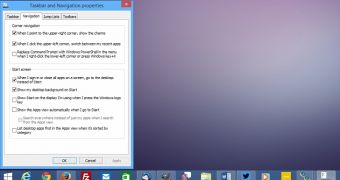The new Windows 8.1 Update, which was officially launched this week for everyone and last week for MSDN subscribers, brings some important tweaks for the boot to desktop option, which was originally implemented in Windows 8.1.
The updated feature, which is supposed to allow users to boot directly to desktop and thus skip the Start screen, comes with improved behavior in Windows 8.1 Update, changing the default configuration depending on the device that you’re using.
Starting with Windows 8.1 Update, all PCs running the operating system are booting directly to the desktop, while devices with touch-capable screens are using the default behavior that still gets users to the Start screen.
At the same time, if you close all Metro apps running on your computer, you are automatically taken to the desktop to quickly access the other installed applications.
“Non-tablet devices will now boot to the desktop. Closing a Windows Store app now takes you back to the previously used app. If you close all apps, it takes your back to the desktop. And pictures, music, and video files now open with associated desktop apps (like Windows Photo Viewer, Windows Media Player, etc.),” Microsoft explains in a blog post detailing the changes made to Windows 8.1 Update.
Windows 8.1 Update comes with plenty of improvements for the desktop, including options to pin Metro apps to the taskbar and launch them in dedicated windows with title bars and minimize and close buttons.
In addition, the Start screen has been tweaked with new options, like context menus and power controls specifically added for PC users still relying on a mouse and keyboard as the main input method.
Microsoft claims that tweaking its modern operating system to work better on the traditional PC isn’t necessarily stepping back, but a way to make sure that Windows 8 is actually appealing to a broader customer range. Touch won’t be abandoned, Terry Myerson, chief of the Windows division, said in a recent interview, adding that the PCs remain a key focus for the company for future Windows updates as well.
The Redmond giant will also bring back the Start menu in another Windows 8.1 update, again in an attempt to turn the operating system into a platform that’s more optimized for the traditional PC and make it more mouse-friendly. No specifics have been provided, but the Start menu comeback is very likely to take place before the end of the year.

 14 DAY TRIAL //
14 DAY TRIAL //